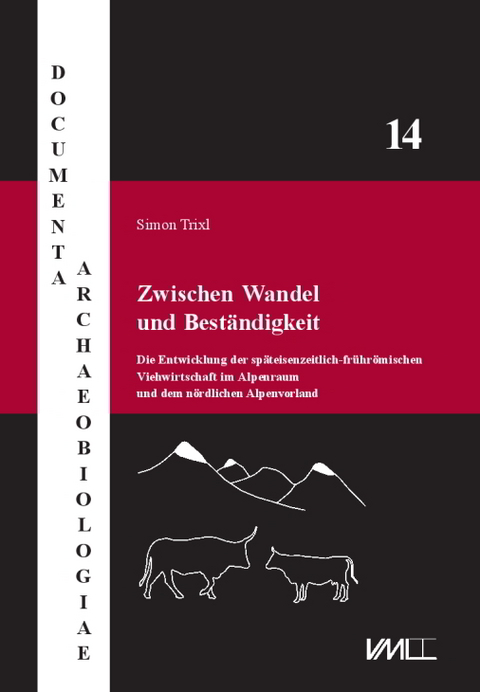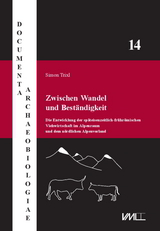Zwischen Wandel und Beständigkeit
Die Entwicklung der späteisenzeitlich-frührömischen Viehwirtschaft im Alpenraum und dem nördlichen Alpenvorland
Seiten
2019
|
1., Aufl.
VML Vlg Marie Leidorf (Verlag)
978-3-89646-630-3 (ISBN)
VML Vlg Marie Leidorf (Verlag)
978-3-89646-630-3 (ISBN)
The late La Tène and early Roman Periods represent a phase of intensive cultural change for the Alpine region and the northern Alpine foreland: Developments such as the collapse of the Oppida Civilisation, the emergence of the final La Tène Southeast-Bavarian Group and the gradual expansion of Rome into the Alps, which culminated in the occupation of the entire mountain region including its northern foreland in 15 B.C., led to massive socio-cultural and economic changes in this region. This monograph examines these processes of cultural change from an archaeozoological perspective. On the basis of 14 archaeofaunas from pre-Roman [Oppida Civilisation, Southeast-Bavarian Group, Fritzens-Sanzeno Culture] and Imperial Period ["Romanised" milieu, Heimstetten Group] contexts presented for the first time, the development of livestock farming between the Danube and the southern edge of the Alps in the centuries around the turn of the Common Era is traced in connection with already published material. The focus here is on the extent to which livestock farming developed continuously from the late Iron Age into Roman times and what changes occurred in animal husbandry under the impression of the complex cultural transitions of this period. A central aspect of this question is also an archaeozoological comparison of the "Romanised" communities with the so-called Heimstetten Group, which is probably the autochthonous population of the province of Raetia. These studies comprise four overarching thematic areas: The supply structures with animal goods, the disposal of food and slaughter waste, the manner of carcass processing and the development of the size and stature of domestic animals. Beyond this economic focus, digressions also provide insight into the changing role of animals in ritual behaviour and burial customs of that period. Die Spätlatènezeit und frühe römische Kaiserzeit stellt für den Alpenraum und das nördliche Alpenvorland eine Phase intensiven kulturellen Wandels dar: Faktoren wie der Zusammenbruch der keltisch geprägten Oppida-Zivilisation, die Entstehung der endlatènezeitlichen Südostbayerischen Gruppe und das sukzessive Ausgreifen Roms in die Alpen, das in der Besetzung des alpinen Gebirgsraumes inklusive seines nördlichen Vorlandes 15 v.Chr. gipfelte, führte zu massiven soziokulturellen und wirtschaftlichen Veränderungen in dieser Region. In dieser Arbeit werden diese Prozesse kulturellen Wandels aus archäozoologischer Sicht untersucht. Auf Basis von 14 erstmals vorgelegten Archäofaunen aus vorrömischen [Oppida-Zivilisation, Südostbayerische Gruppe, Fritzens-Sanzeno-Kultur] und kaiserzeitlichen [„romanisiertes“ Milieu, Heimstettener Gruppe] Kontexten wird in Verbindung mit bereits publiziertem Material die Entwicklung der Viehwirtschaft zwischen Donau und südlichem Alpenrand in den Jahrhunderten um die Zeitenwende nachgezeichnet. Im Fokus steht dabei die Frage, auf welcher Basis sich die Viehwirtschaft von der Eisenzeit bis in die Kaiserzeit kontinuierlich entwickelte und zu welchen Veränderungen es unter dem Eindruck der komplexen kulturellen Umbrüche dieser Zeit kam. Zentral ist für diese Fragestellung auch ein archäozoologischer Vergleich der „romanisierten“ Gemeinschaften mit der sog. Heimstettener Gruppe, bei der es sich um die autochthone Bevölkerung der Provinz Rätien handeln dürfte. Diese Untersuchungen umfassen vier übergeordnete Themenbereiche: Die Versorgung der Bevölkerung mit tierischen Gütern, die Entsorgungsweise von Speiseabfall und Schlachtabfall, die Zerlegungsweise der Schlachtkörper und die Entwicklung von Größe und Wuchsform der Haustiere. Über diesen ökonomischen Schwerpunkt hinaus geben Exkurse zudem Einblick in die sich wandelnde Rolle von Tieren in Kult und im Bestattungsritus jener Zeit.
The late La Tène and early Roman Periods represent a phase of intensive cultural change for the Alpine region and the northern Alpine foreland: Developments such as the collapse of the Oppida Civilisation, the emergence of the final La Tène Southeast-Bavarian Group and the gradual expansion of Rome into the Alps, which culminated in the occupation of the entire mountain region including its northern foreland in 15 B.C., led to massive socio-cultural and economic changes in this region. This monograph examines these processes of cultural change from an archaeozoological perspective. On the basis of 14 archaeofaunas from pre-Roman [Oppida Civilisation, Southeast-Bavarian Group, Fritzens-Sanzeno Culture] and Imperial Period ["Romanised" milieu, Heimstetten Group] contexts presented for the first time, the development of livestock farming between the Danube and the southern edge of the Alps in the centuries around the turn of the Common Era is traced in connection with already published material. The focus here is on the extent to which livestock farming developed continuously from the late Iron Age into Roman times and what changes occurred in animal husbandry under the impression of the complex cultural transitions of this period. A central aspect of this question is also an archaeozoological comparison of the "Romanised" communities with the so-called Heimstetten Group, which is probably the autochthonous population of the province of Raetia. These studies comprise four overarching thematic areas: The supply structures with animal goods, the disposal of food and slaughter waste, the manner of carcass processing and the development of the size and stature of domestic animals. Beyond this economic focus, digressions also provide insight into the changing role of animals in ritual behaviour and burial customs of that period.
The late La Tène and early Roman Periods represent a phase of intensive cultural change for the Alpine region and the northern Alpine foreland: Developments such as the collapse of the Oppida Civilisation, the emergence of the final La Tène Southeast-Bavarian Group and the gradual expansion of Rome into the Alps, which culminated in the occupation of the entire mountain region including its northern foreland in 15 B.C., led to massive socio-cultural and economic changes in this region. This monograph examines these processes of cultural change from an archaeozoological perspective. On the basis of 14 archaeofaunas from pre-Roman [Oppida Civilisation, Southeast-Bavarian Group, Fritzens-Sanzeno Culture] and Imperial Period ["Romanised" milieu, Heimstetten Group] contexts presented for the first time, the development of livestock farming between the Danube and the southern edge of the Alps in the centuries around the turn of the Common Era is traced in connection with already published material. The focus here is on the extent to which livestock farming developed continuously from the late Iron Age into Roman times and what changes occurred in animal husbandry under the impression of the complex cultural transitions of this period. A central aspect of this question is also an archaeozoological comparison of the "Romanised" communities with the so-called Heimstetten Group, which is probably the autochthonous population of the province of Raetia. These studies comprise four overarching thematic areas: The supply structures with animal goods, the disposal of food and slaughter waste, the manner of carcass processing and the development of the size and stature of domestic animals. Beyond this economic focus, digressions also provide insight into the changing role of animals in ritual behaviour and burial customs of that period.
| Erscheinungsdatum | 04.07.2019 |
|---|---|
| Reihe/Serie | Documenta Archaeobiologiae ; 14 |
| Verlagsort | Rahden/Westf. |
| Sprache | deutsch |
| Maße | 210 x 297 mm |
| Gewicht | 1760 g |
| Einbandart | gebunden |
| Themenwelt | Geschichte ► Allgemeine Geschichte ► Vor- und Frühgeschichte |
| Schlagworte | Archäozoologie • eisenzeitliche Viehwirtschaft • Heimstettener Gruppe • Kulturwandel • Rätien • römische Viehwirtschaft |
| ISBN-10 | 3-89646-630-5 / 3896466305 |
| ISBN-13 | 978-3-89646-630-3 / 9783896466303 |
| Zustand | Neuware |
| Haben Sie eine Frage zum Produkt? |
Mehr entdecken
aus dem Bereich
aus dem Bereich
auf den Spuren der frühen Zivilisationen
Buch | Hardcover (2023)
C.H.Beck (Verlag)
20,00 €
Was Pompeji über uns erzählt
Buch | Hardcover (2023)
Propyläen (Verlag)
32,00 €




